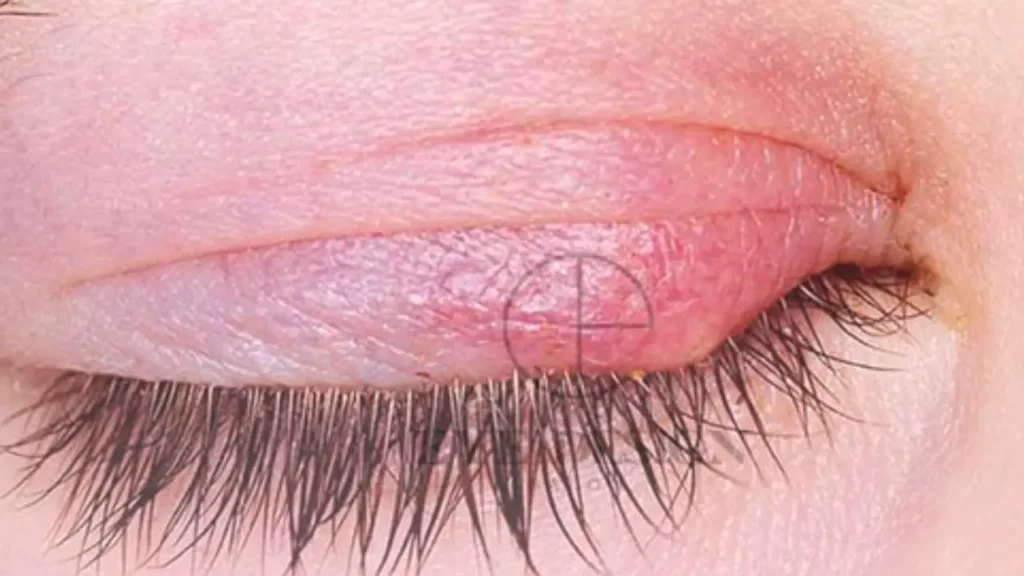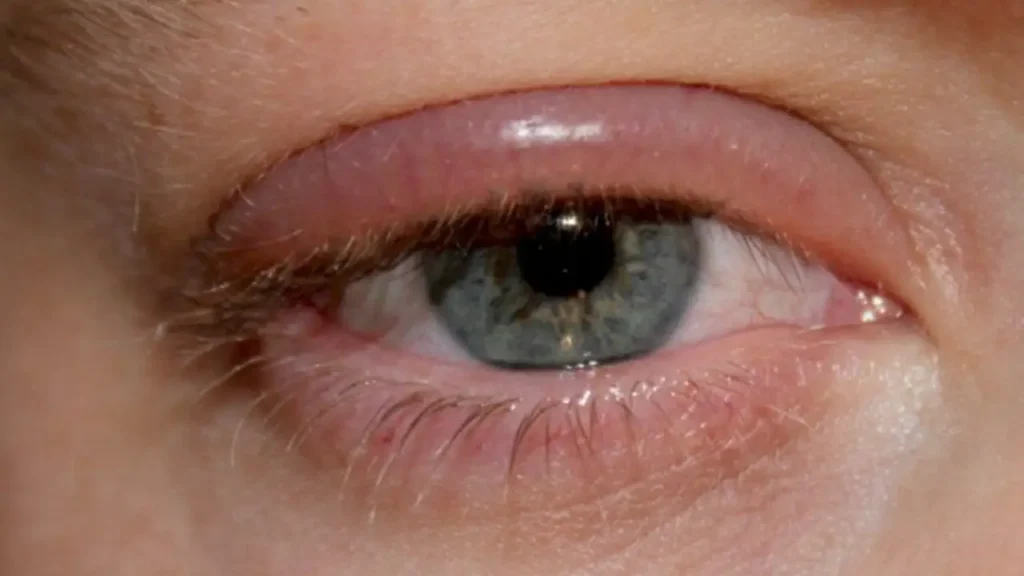![]()
Blepharitis, an inflammation of the eyelids, can be a frustrating and sometimes painful condition. While lash extensions can enhance beauty, they can also potentially exacerbate existing blepharitis or even contribute to its development.
This blog post will explore the connection between blepharitis and lash extensions, delve into the potential causes, and provide valuable tips on how to prevent and manage this condition while still enjoying the beauty of lash enhancements.
Lash Extension Blepharitis Symptoms

Blepharitis is an inflammation of the eyelids that can be exacerbated by lash extensions.
Here’s a deeper look at the blepharitis from lash extensions symptoms:
- Redness and Swelling: The eyelids may appear red, swollen, and puffy, particularly along the base of the eyelashes.
- Itching and Burning: Intense itching and a burning sensation around the eyes are common.
- Crusting and Flaking: You may notice crusty flakes or scales forming at the base of the eyelashes.
- Watery Eyes: Excessive tearing or, conversely, dry eyes can occur.
- Light Sensitivity: Some individuals may experience increased sensitivity to light.
- Blurred Vision: In some cases, blepharitis can cause temporary blurred vision.
- Foreign Body Sensation: It may feel like there’s something constantly irritating the eyes, such as sand or grit.
Important Note:
- These symptoms can vary in severity.
- If you experience any of these symptoms after getting lash extensions, it’s crucial to consult with an ophthalmologist or a qualified lash artist to determine the cause and receive appropriate treatment.
Remember, if you suspect you have blepharitis, it’s essential to seek professional medical advice for proper diagnosis and treatment.
Can Lash Extensions Cause Blepharitis
Yes, lash extensions can increase the risk of developing or worsening blepharitis. Here’s how:
Allergic Reactions:
The adhesive used to apply lash extensions can trigger allergic reactions in some individuals. Common allergens include cyanoacrylate (the main component of lash glue) and certain preservatives.
These allergic reactions can irritate the eyelids and contribute to the development of blepharitis.
Poor Hygiene:
Improper application techniques and poor hygiene practices during the application process can introduce bacteria or other irritants to the eyelids.
This can increase the risk of infection and inflammation, which are key factors in blepharitis.
Weight and Stress:
The weight of the lash extensions can put additional stress on the eyelids, potentially irritating the delicate tissues and contributing to inflammation.
Difficulty with Eyelid Hygiene:
The presence of lash extensions can make it more difficult to properly clean the eyelids, which is crucial for preventing blepharitis.
Buildup of oil, bacteria, and other debris around the lash line can irritate the eyelids and worsen the condition.
Important Note:
- Not everyone who gets lash extensions will develop blepharitis.
- The risk is higher for individuals with pre-existing eye conditions or sensitivities.
If you have concerns about the potential risks of lash extensions or if you experience any symptoms of blepharitis, consult with an ophthalmologist or a qualified lash artist.
Why Blepharitis Happens After Lash Extensions

This is for informational purposes only. For medical advice or diagnosis, consult a professional.
Lash extensions can increase the risk of developing or worsening blepharitis, an inflammation of the eyelid margins.
Here’s how:
- Allergic Reactions:
- The adhesive used to apply lash extensions can trigger allergic reactions in some individuals. Common allergens include cyanoacrylate (the main component of lash glue) and certain preservatives. These allergic reactions can irritate the eyelids and contribute to the development of blepharitis.
- Poor Hygiene:
- Improper application techniques and poor hygiene practices during the application process can introduce bacteria or other irritants to the eyelids. This can increase the risk of infection and inflammation, which are key factors in blepharitis.
- Weight and Stress:
- The weight of the lash extensions can put additional stress on the eyelids, potentially irritating the delicate tissues and contributing to inflammation.
- Difficulty with Eyelid Hygiene:
- The presence of lash extensions can make it more difficult to properly clean the eyelids, which is crucial for preventing blepharitis. Buildup of oil, bacteria, and other debris around the lash line can irritate the eyelids and worsen the condition.
- Disruption of the Meibomian Glands:
- The Meibomian glands are tiny oil glands located along the eyelid margins that produce an oily substance that helps maintain the tear film.
- Lash extensions, especially if applied improperly, can potentially interfere with the normal function of these glands. This can lead to a buildup of oil and debris, contributing to clogged glands and subsequent inflammation.
Important Note:
- Not everyone who gets lash extensions will develop blepharitis.
- The risk is higher for individuals with pre-existing eye conditions or sensitivities.
If you have concerns about the potential risks of lash extensions or if you experience any symptoms of blepharitis, consult with an ophthalmologist or a qualified lash artist.
Eyelids Swollen After Lash Extensions
Swollen eyelids after getting lash extensions can be a sign of an allergic reaction or other irritation. Here are some possible causes:
- Allergic Reaction:
- Adhesive: The most common culprit is an allergy to the adhesive used to apply the extensions. Common allergens include cyanoacrylate (the main component of lash glue) and certain preservatives.
- Extension Materials: Some individuals may experience allergies or sensitivities to the materials used to make the extensions themselves, such as mink, silk, or synthetics.
- Infection:
- Poor Hygiene: If the lash application area wasn’t properly sanitized or if your lash artist had poor hygiene practices, it could increase the risk of infection.
- Eyelid Hygiene: Not properly cleaning your eyelids can lead to the buildup of bacteria and irritants, which can cause inflammation and swelling.
- Improper Application:
- Too Much Adhesive: Excess adhesive can irritate the delicate skin around your eyes.
- Incorrect Isolation: If your natural lashes weren’t properly isolated during the application process, multiple lashes may be glued together, causing discomfort and irritation.
- Other Factors:
- Weight of Extensions: In some cases, the weight of the extensions, especially if they are very heavy or numerous, can put extra strain on the eyelids, leading to slight swelling.
What to Do:
- Consult a Professional: If the swelling is severe, persistent, or accompanied by other concerning symptoms like redness, itching, or vision changes, consult with an ophthalmologist or a qualified lash artist.
- Practice Good Hygiene:
- Wash your hands thoroughly before and after touching your eyes.
- Gently cleanse your eyelids with a mild, oil-free cleanser.
- Avoid touching your eyes excessively.
Important Note:
- Do not rub your eyes! This can worsen the irritation and dislodge the extensions.
Remember, it’s crucial to address any eyelid swelling after lash extensions promptly to prevent potential complications.
How to Get Rid of Swollen Eyes From Lash Extensions
This is for informational purposes only. For medical advice or diagnosis, consult a professional.
If your eyelids are swollen after getting lash extensions, here are some steps you can take to find relief:
- Cold Compress: Apply a cool compress to your eyes for a few minutes at a time, several times a day. This can help reduce inflammation and soothe irritation.
- Warm Compress (Optional): After the initial swelling subsides, a warm compress may help to improve circulation and promote healing.
- Artificial Tears: Over-the-counter artificial tears can help lubricate your eyes and relieve dryness, which can sometimes accompany eyelid swelling.
- Avoid Irritants:
- Avoid touching your eyes excessively.
- Minimize exposure to smoke, dust, and other irritants.
- Use only oil-free makeup removers and cleansers specifically designed for use with lash extensions.
- Consult a Professional:
- If the swelling is severe, persistent, or accompanied by other concerning symptoms like redness, itching, or vision changes, consult with an ophthalmologist or a qualified lash artist. They can help determine the cause of the swelling and recommend appropriate solutions.
Important Note:
- Do not rub your eyes! This can worsen the irritation and dislodge the extensions.
Remember, it’s crucial to address any eyelid swelling after lash extensions promptly to prevent potential complications.
How to Prevent Lash Extension Blepharitis

Preventing blepharitis associated with lash extensions involves a multi-faceted approach:
1. Choose a Qualified Lash Artist:
- Hygiene: Ensure the lash studio and the lash artist maintain strict hygiene standards. This includes proper sterilization of tools and a clean working environment.
- Experience and Training: Select a lash artist with experience and training in lash extension application techniques.
- Product Quality: Inquire about the quality of the lash extensions and the adhesive used. Look for high-quality, low-irritant products.
2. Prioritize Eyelid Hygiene:
- Gentle Cleansing: Clean your eyelids daily with a gentle, oil-free cleanser specifically designed for use with lash extensions. This helps remove oil, bacteria, and makeup residue that can contribute to irritation.
- Avoid Rubbing: Avoid excessive rubbing or touching your eyes, as this can dislodge extensions and irritate the eyelids.
3. Minimize Risk Factors:
- Adhesive Sensitivity: If you have sensitive skin or a history of allergies, discuss potential sensitivities with your lash artist. Consider a patch test with the adhesive before a full set of extensions.
- Extension Weight: Opt for lighter, shorter extensions, especially if you have sensitive eyes.
4. Regular Maintenance:
- Fillers: Schedule regular fill appointments to replace fallen extensions and maintain the health of your natural lashes.
- Breaks: Consider taking breaks from lash extensions periodically to allow your natural lashes to rest and recover.
5. Address Underlying Conditions:
- Treat Existing Conditions: If you have pre-existing eye conditions such as dry eye or blepharitis, address these issues with your ophthalmologist before getting lash extensions.
By following these preventative measures, you can significantly reduce the risk of developing blepharitis associated with lash extensions and enjoy a safer, more comfortable lash experience.
Conclusion
Blepharitis, an inflammation of the eyelid margins, can be exacerbated by lash extensions. Factors like adhesive reactions, poor hygiene, and improper application techniques can contribute to this issue. Prioritizing eyelid hygiene, choosing a qualified lash artist, and using high-quality, low-irritant products are crucial for minimizing the risk of blepharitis and maintaining healthy, beautiful lashes.
Ready to offer your clients the safest lash extension experience?
Source high-quality, low-irritant lash extensions from [Your Company Name]. Our premium mink and silk lashes are crafted with client safety in mind, using gentle adhesives and rigorous quality control.
Visit our website today to browse our extensive selection and prioritize client well-being.
